Unit 1 Notes
Covers: 7-2; 3-4; 3-2, 3-3 & 5-1; 8-4 & 8-5
2-3, 2-4, 3-2, 3-3, & 3-4: Energy & Matter
Energy
Energy is the capacity to do work or transfer heat
Two Kinds of Energy moving (kinetic) & stored (potential) energy.
Kinetic Energy is associated with motion
Heat / Thermal Energy & Electromagnetic Radiation
Potential Energy is stored and could be potentially used
Potential Energy can be changed to Kinetic Energy
Energy Quality is how easy and useful energy is
High-Quality Energy is energy that's concentrated and easy to use, like electricity or fossil fuels, with little waste.
Low-Quality Energy is energy that's spread out and not as useful
Leads to more waste and less efficiency, like heat or movement
First Law of Thermodynamics states that energy cannot be created or destroyed
aka Law of Conservation of Energy
Second Law of Thermodynamics states that energy changes from high quality to low quality as it transforms from one form to another
aka Law of Conservation of Matter
Systems
Systems are interconnected components and processes that work together
Inputs: Resources or factors that enter a system
Sunlight, Water, Nutrients, etc.
Throughputs: Internal processes that transform or use the inputs
Photosynthesis
Outputs: Results or products that the system produces
Oxygen produced by plants
Feedback loops are mechanisms that influence how a system responds to changes.
Positive Feedback Loop is when a change makes things get even more extreme in the same way.
Ice Melts → Exposes Dark Water → Dark Water absorbs Sunlight → More Heat → More Ice melts
Can be good and bad
Negative Feedback Loop is when changes stabilize a system
Ex: Human body temp rises, humans sweat to cool down.
Ecosystems
Ecology is the science that explores how living things and their surroundings work together
5 Levels of Interactions are organism, population, community, ecosystem, and biosphere
Organism is an individual living being
Population are groups of the same species living in a specific area
Communities consist of all the different species living in the same area
Ecosystems have all living organisms and their physical environment in a given region
The Biosphere includes all ecosystems on Earth, where life exists
Trophic Level is a specific rank in the food chain that describes an organism's role in capturing or consuming energy and nutrients.
Producers (autotrophs) use nutrients from their environment (photosynthesis)
Primary consumers (herbivores) eat mostly green plants (caterpillars, giraffes, etc.)
Secondary consumers (carnivores) are animals that eat other animals (Spiders, lions, etc.)
Tertiary consumers eat secondary consumers (tigers, killer whales, etc.)
Decomposers break down dead plant and animal material
Returns nutrients to the soil, water, and air for producers
Detritivores feed on the dead bodies of organisms (vultures)
Energy in Ecosystems
Food Chain is a line that shows how animals and plants eat each other to get energy
Food webs are networks of interconnected food chains
Represents the complex interactions of multiple species in an ecosystem
Biomass is the total weight of all living things in an area or ecosystem
10% Rule is where in each tropic level, 90% of energy is lost (10% transferred to next level)
Gross Primary Productivity (GPP) total energy plants capture from the sun through photosynthesis before they use some of it for their own needs
Net Primary Productivity (NPP) is the energy left over for other organisms after plants have used some for themselves.
Cycles in Ecosystems
Hydrologic, Carbon, Nitrogen, Phosphate, & Sulfur Cycle
Refer to drawings
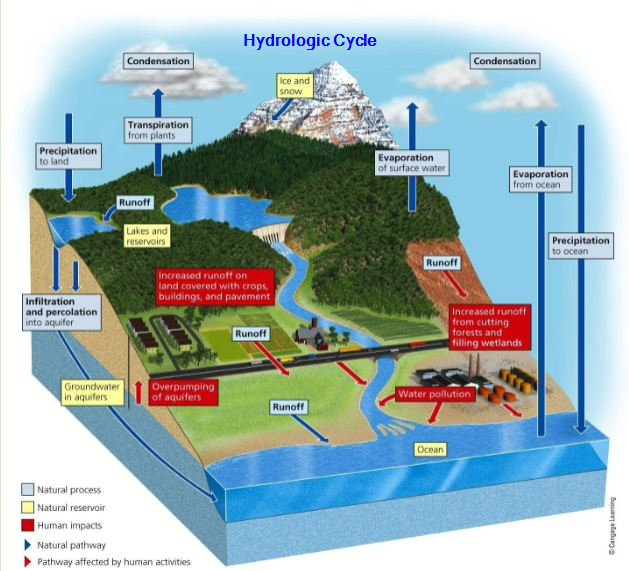
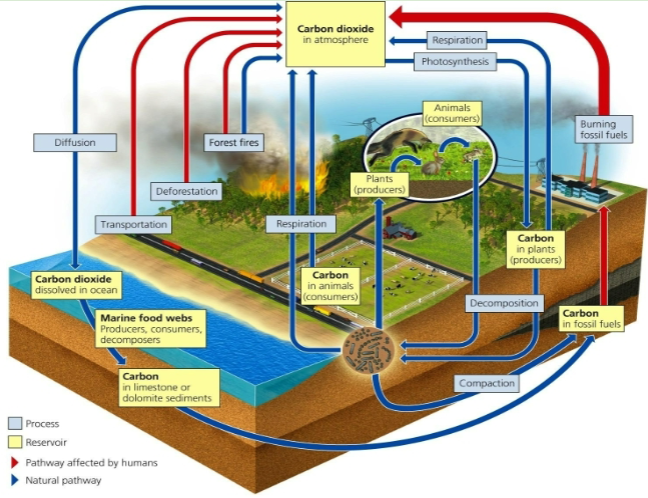
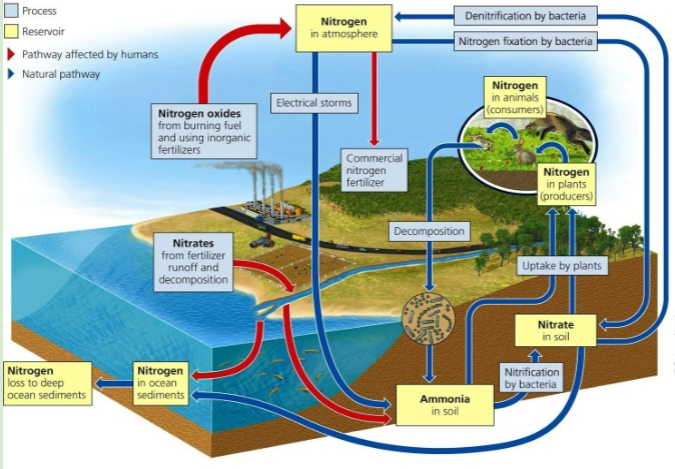
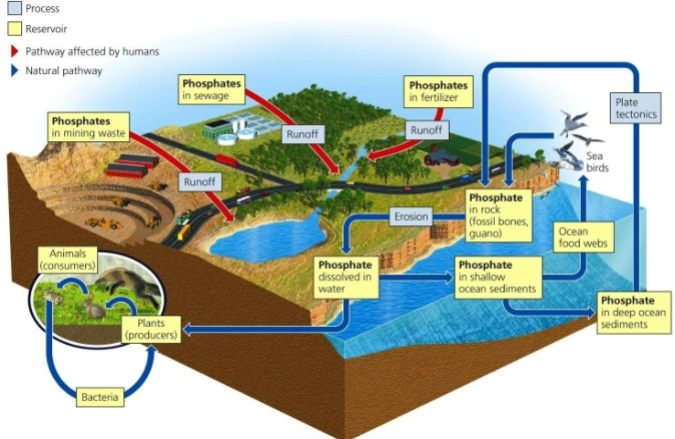
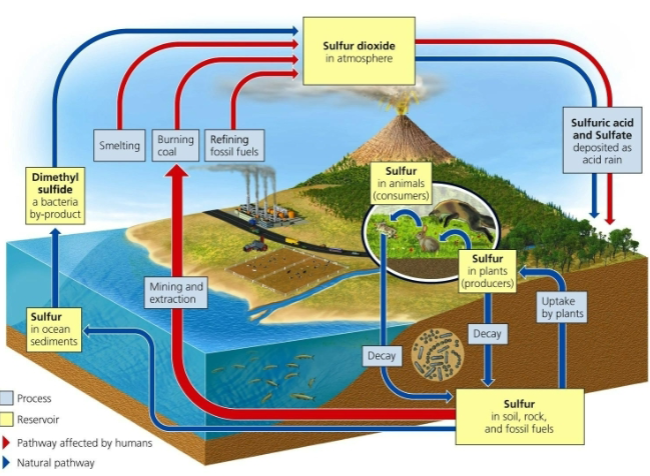
5-1: Species Interactions
Aquatic Life Zones = oceanic biomes
Species interactions are ways different types of organisms affect each other.
Interspecific competition is when different species compete for the same resources.
Predation is when one organism hunts and eats another.
Parasitism is when one organism benefits at the expense of another by living on or inside it.
Mutualism is a relationship where both organisms benefit.
Commensalism is a relationship where one organism benefits, and the other is neither helped nor harmed.
Interspecific competition is when different species compete for resources
Niche Overlap occurs when they share similar resource needs and resource partitioning when they divide resources to reduce competition.
Predator-Prey Relationships involve (predator) hunting and consuming another (prey)
Predators use various techniques to catch prey → Prey develop avoidance strategies
→ Leads to co-evolution (mutual adaptation) over time.
7-2: Climate + Location = Biomes
Terrestrial Biomes
Climate + global air circulation & ocean currents = varying types of biomes
Climate and vegetation vary according to latitude and elevation
Biomes are large terrestrial regions, characterized by certain climates & plant life.
Productivity is how quickly plants and animals grow and make new life in an ecosystem.
Deserts, Grasslands, & Forests
A Desert has low & scattered annual precipitation
During Day, sun warms ground and evaporates water
During night, heat radiates into atmosphere
Three Desert Types are tropical, temperate, and cold deserts.
Tropical Deserts are hot & dry with few plants
Temperate Deserts are hot in summers / cooler in winters, more precipitation, and more (but sparse) vegetation
Cold Deserts have cold winters, warm summers, low precipitation, and many types of vegetation.
Three Grassland Types are tropical, temperate, and cold (artic tundra)
Tropical Grasslands (savanna) are warm all year long, have sparse plants, and grazing (grass eating) animals
Temperate Grasslands (prairie) have cold winters, hot/dry summers, very fertile soil, lots of grass (most used biome for farms), and sparse trees
Cold Grasslands (artic tundra) bitterly cold, treeless, permafrost, thick coated animals, and fragile ecosystem.
Permafrost is frozen underground soil, creating shallow ponds when rain falls.
Three Forest Types are tropical, temperate, and cold
Tropical Rain Forests are found near equator, year-round warm, moist, daily rainfall, broadleaf evergreen plants, minimal floor vegetation, and high productivity
Temperate Deciduous Forest cooler temperatures and fewer/slower decomposers
Think New York / Pennsylvania forests
Cold / Northern Coniferous Forests / Boreal Forests have long winters, extremely cold, minimal sunlight, and dominated by few species.
Think Alaska & Evergreen Trees
Mountains
Contain majority of world forests
Habitats for endemic species, aka species not found anywhere else in the world
Sanctuaries for animals that are migrating
Play a critical role in the hydrological cycle (snow/ice)
Aquatic Biomes
Aquatic systems can be broadly categorized into marine (oceanic) and freshwater zones.
Turbidity Is cloudiness in water that can block photosynthesis
Most photosynthesis occurs in the euphotic zone
More algae = more cloudiness
Excessive Human Caused Runoff = more cloudiness
Aquatic Organisms are classified into three main groups:
plankton (small, drifting organisms)
Algae & Small Plants / Animals (Base of food chain)
Produces half of earth’s oxygen
nekton (swimming organisms)
Fish, turtles, & whales
benthos (organisms living on the bottom of bodies of water)
Oysters & Sea Stars
decomposers (bacteria) breaking down organic matter.
Exist in different areas based on: temperature, oxygen content, food availability, and amount of light / nutrients
Marine Aquatic (Saltwater) Systems include various zones:
Coastal zones are diverse areas where land meets the sea, offering a mix of ecosystems
Beaches, rocky shores, and wetlands
90% of marine / oceanic species
Estuaries is where a river (freshwater) meets the sea (saltwater)
Coastal wetlands filter water, provide homes for many species, and help prevent coastal erosion.
Related to estuaries
High nutrient input from rivers, rapid circulation of nutrients, & ample sunlight from shallow waters
High productivity
Marshes and Swamps (Mangrove forests)
Intertidal zones area of shoreline between high & low tides
Organisms need to avoid being swept away
Salinity will change frequently
The Open Sea sharp increase in water depth separating the coastal zone.
All these biomes can be destroyed by: costal development, runoff, pollution, overfishing, invasive species, ocean warming, and ocean acidification
Freshwater Aquatic Systems:
Surface water Bodies of freshwater on the Earth's surface, such as ponds, lakes, and reservoirs
Precipitation that doesn’t sink into ground / evaporate
Runoff is surface water that flows into bodies of water
Watershed Area of land that drains into a specific body of water, including all the rivers, streams, and tributaries that feed it
Depositors sediment and dissolved substances
Lakes Large bodies of freshwater often formed in depressions in the Earth's surface, with various sizes and characteristics.
Three Layers: Limnetic, Profundal, & Benthic Zones
Rivers & Streams:
Rivers are typically larger, flowing bodies of freshwater
Streams are smaller
Both vital for transporting water and nutrients through landscapes.
River Deltas Where rivers meet the sea, forming unique and highly productive ecosystems due to sediment deposition.
Water flows in order: Source Zone, Transition Zone, & Floodplane Zone
Inland Wetland Waterlogged areas found away from the coast
Swamps and marshes
Supports diverse species & does functions like water purification and flood control.
Lakes are divided into zones:
oligotrophic (nutrient-poor)
mesotrophic (moderate nutrient levels)
eutrophic (nutrient-rich) lakes, with cultural eutrophication referring to human-induced nutrient enrichment in bodies of water.
Human impacts:
Dams and canals restrict 40% of rivers → destroyed terrestrial & aquatic habitats (like deltas and estuaries)
Flood control levees / methods destroy similar habitats
Cities and farms add polutiants to freshwater systems
Ex: lakes with runoff from fertilizers causes explosions of algae, deprecating the lake’s oxygen supply
Inand wetlands being drained for farmland / urban development.
Changing freshwater and marine ecosystems by altering water quality
Introducing pollutants
Affecting habitat and species
→ Consequences for ecosystem health and the services they provide
 Knowt
Knowt
